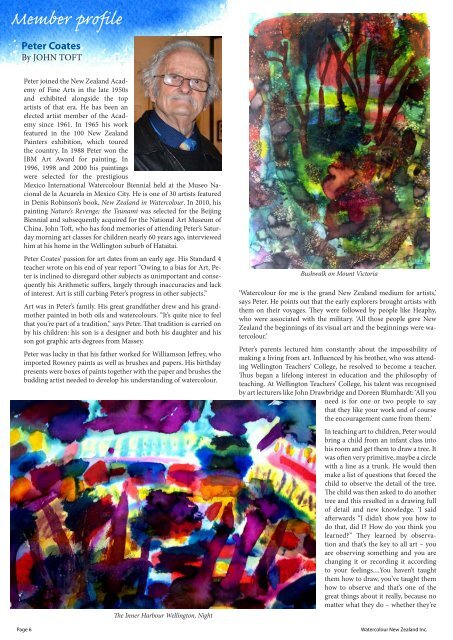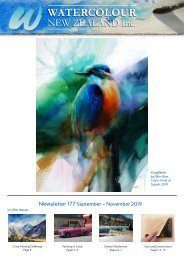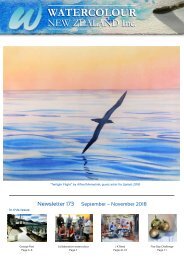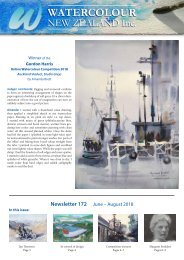Watercolour New Zealand Newsletter #171
Watercolour New Zealand Newsletter #171 March - May 2018 http://www.watercolournewzealand.nz
Watercolour New Zealand Newsletter #171 March - May 2018 http://www.watercolournewzealand.nz
You also want an ePaper? Increase the reach of your titles
YUMPU automatically turns print PDFs into web optimized ePapers that Google loves.
Member profile<br />
Peter Coates<br />
By JOHN TOFT<br />
Peter joined the <strong>New</strong> <strong>Zealand</strong> Academy<br />
of Fine Arts in the late 1950s<br />
and exhibited alongside the top<br />
artists of that era. He has been an<br />
elected artist member of the Academy<br />
since 1961. In 1965 his work<br />
featured in the 100 <strong>New</strong> <strong>Zealand</strong><br />
Painters exhibition, which toured<br />
the country. In 1988 Peter won the<br />
IBM Art Award for painting. In<br />
1996, 1998 and 2000 his paintings<br />
were selected for the prestigious<br />
Mexico International <strong>Watercolour</strong> Biennial held at the Museo Nacional<br />
de la Acuarela in Mexico City. He is one of 30 artists featured<br />
in Denis Robinson’s book, <strong>New</strong> <strong>Zealand</strong> in <strong>Watercolour</strong>. In 2010, his<br />
painting Nature’s Revenge; the Tsunami was selected for the Beijing<br />
Biennial and subsequently acquired for the National Art Museum of<br />
China. John Toft, who has fond memories of attending Peter’s Saturday<br />
morning art classes for children nearly 60 years ago, interviewed<br />
him at his home in the Wellington suburb of Hataitai.<br />
Peter Coates’ passion for art dates from an early age. His Standard 4<br />
teacher wrote on his end of year report “Owing to a bias for Art, Peter<br />
is inclined to disregard other subjects as unimportant and consequently<br />
his Arithmetic suffers, largely through inaccuracies and lack<br />
of interest. Art is still curbing Peter’s progress in other subjects.”<br />
Art was in Peter’s family. His great grandfather drew and his grandmother<br />
painted in both oils and watercolours. “It’s quite nice to feel<br />
that you’re part of a tradition,” says Peter. That tradition is carried on<br />
by his children: his son is a designer and both his daughter and his<br />
son got graphic arts degrees from Massey.<br />
Peter was lucky in that his father worked for Williamson Jeffrey, who<br />
imported Rowney paints as well as brushes and papers. His birthday<br />
presents were boxes of paints together with the paper and brushes the<br />
budding artist needed to develop his understanding of watercolour.<br />
The Inner Harbour Wellington, Night<br />
Bushwalk on Mount Victoria<br />
‘<strong>Watercolour</strong> for me is the grand <strong>New</strong> <strong>Zealand</strong> medium for artists,’<br />
says Peter. He points out that the early explorers brought artists with<br />
them on their voyages. They were followed by people like Heaphy,<br />
who were associated with the military. ‘All those people gave <strong>New</strong><br />
<strong>Zealand</strong> the beginnings of its visual art and the beginnings were watercolour.’<br />
Peter’s parents lectured him constantly about the impossibility of<br />
making a living from art. Influenced by his brother, who was attending<br />
Wellington Teachers’ College, he resolved to become a teacher.<br />
Thus began a lifelong interest in education and the philosophy of<br />
teaching. At Wellington Teachers’ College, his talent was recognised<br />
by art lecturers like John Drawbridge and Doreen Blumhardt: ‘All you<br />
need is for one or two people to say<br />
that they like your work and of course<br />
the encouragement came from them.’<br />
In teaching art to children, Peter would<br />
bring a child from an infant class into<br />
his room and get them to draw a tree. It<br />
was often very primitive, maybe a circle<br />
with a line as a trunk. He would then<br />
make a list of questions that forced the<br />
child to observe the detail of the tree.<br />
The child was then asked to do another<br />
tree and this resulted in a drawing full<br />
of detail and new knowledge. ‘I said<br />
afterwards “I didn’t show you how to<br />
do that, did I? How do you think you<br />
learned?” They learned by observation<br />
and that’s the key to all art – you<br />
are observing something and you are<br />
changing it or recording it according<br />
to your feelings....You haven’t taught<br />
them how to draw, you’ve taught them<br />
how to observe and that’s one of the<br />
great things about it really, because no<br />
matter what they do – whether they’re<br />
Peter Coates demonstrating at Splash<br />
playing rugby or cooking – observation is an absolutely key element.’<br />
The basis of creating satisfying symbols in art, says Peter, is observation<br />
of both the visual reality and the personal feelings involved with<br />
that reality. He quotes Barry Brickell who said ‘There’s no such thing<br />
as bad art, only boring art.’ Boring art, Peter maintains, is art where<br />
the artist has lacked passion. ‘Passion is a part of the way that I paint.<br />
If you can see the structure and the size of my paintings you can see<br />
that I paint with passion.... If I don’t feel something about the subject,<br />
I don’t paint it. It’s the feeling that drives the way I paint. If I don’t get<br />
the feeling of the place my hands won’t move properly and I’ll end up<br />
with a boring painting. And I’ve painted boring paintings. Everybody<br />
does.... I’ve got piles of old paintings that will end up being burnt<br />
somewhere. Everybody has.’<br />
Peter says his style has evolved through his love of calligraphy: ‘I see<br />
all the strokes in a painting as being calligraphy and you paint according<br />
to the way your hands move and your arms move. Some people<br />
get pleasure out of little movements and tiny details, some people<br />
move their hands. I’m a mover of hands. I learned it from stage painting<br />
because you paint big.’<br />
The problem facing the professional artist, according to Peter, is that<br />
to some degree artists have to paint to sell but they also have to get<br />
pleasure from what they do. ‘It’s a very difficult thing to get the balance<br />
right .... Our audience tends to be conservative and if you want<br />
to grow as an artist you can’t afford to be conservative. You’re very<br />
lucky if you can paint what you want to paint and people will buy it.<br />
That is the optimum and there are certain artists who can survive in<br />
that way but it’s a very difficult road.’<br />
These days, Peter feels that his paintings are probably selling better<br />
then they have at any time in the past. ‘I’d like to believe that the audience<br />
would like a little bit of me on their walls and each time they<br />
walk past it they’ll think “Oh well, there’s Peter Coates in this house<br />
and I’m glad he’s on the wall.”’<br />
Peter has this advice for aspiring artists: ‘Persevere. If you want to really<br />
be a painter you’ve got to feel that you’re going to be kicked in the<br />
butt regularly. Every now and again you’ll feel you’re being ignored.<br />
You’ve just got to persevere and you’ve got to have a passion...All the<br />
great painters I’ve ever read all say the same thing: don’t get caught up<br />
in technique. I would say technique is the servant of the artist rather<br />
than the master. If technique becomes the master you may as well<br />
give up because if you’re searching for technique you end up copying<br />
someone else and you never end up making it your own... A beginner<br />
will tend to think that if their technique is good then they’re a good<br />
painter. But they’re only a good painter if they’re using their technique<br />
to say something and if they’re saying something that’s boring<br />
then it’s not art. Simple, but very hard to do.’<br />
Girl with red towel<br />
One of the great pitfalls in painting, Peter says, is that people tend<br />
to get to a certain stage in their growth and then continue to paint<br />
the same subject matter in the same way. ‘I would like to see a<br />
<strong>New</strong> <strong>Zealand</strong> painter who forced me to observe something differently.’<br />
Page 6 <strong>Watercolour</strong> <strong>New</strong> <strong>Zealand</strong> Inc. www.watercolournewzealand.co.nz<br />
Page 7





